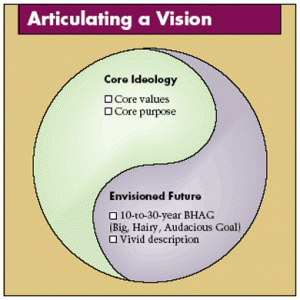 In rapidly changing times, it is more important than ever to have a clear vision of where your organization or department is headed.
In rapidly changing times, it is more important than ever to have a clear vision of where your organization or department is headed.
Think about it: How can you define what to do without a strong picture of your desired destination?
And how can all the units and individuals in your organization move forward without the same destination in mind?
Your envisioned future can serve as your compass and your engine – powering you forward – even in turbulent times.
You are ready to envision the future once your organization has nailed down its core ideology. Core ideology is the combination of an organization’s values, the three to five basic tenets that define its character; and its purpose, the organization’s key reason for being.
Core ideology is central to the strategic planning framework Jim Collins and Jerry Porras describe in their classic article, “Building Your Company’s Vision” — and core purpose and values are discussed in other Wunderlin Company newsletters.
Vision is the next step. It is critical whether your organization is struggling – or leading the pack.
When Ford Motor Company was recruiting Alan Mulally from Boeing in 2006 to lead its turnaround, Mulally reportedly listed one of the first items of business as: “Clear, compelling vision going forward.”
Amazon’s vision statement begins with a clear picture: “We seek to be Earth’s most customer-centric company for… consumers, sellers, enterprises, and content creators.”
Brown-Forman’s website starts its vision this way: “We enrich the experience of life in our own way by responsibly building beverage alcohol brands that thrive and endure for generations…”
So in this edition of this newsletter we look at developing an organization’s vision–we focus on your trajectory and charting the best course forward.
Designing a Vision
Experience shows the powerful effect of defining a clear and ambitious “desired future.”
Here is a classic experience: One of our clients kicked off a round of strategic planning. The leadership group began by going back to a simple one-afternoon vision and goal-setting session we had held three years earlier.
To everyone’s surprise and satisfaction, the company had achieved their “vision” sales target two years ahead of schedule. And, when that target was first stated, it was clearly ambitious beyond the team’s wildest imagination. That success has propelled the company to set a new vision for increasing those sales five-fold.
A vision is a short, clear statement of what you want to be true for you or your organization at a specifically stated point in time. The time frame will be set by the industry in which your organization operates. We have worked with time frames as short as two years for high- tech companies and as long as 20 years for infrastructure and utility organizations.
From our view, the benefit of visioning can be comprehensive. Personal planning is a tremendously useful endeavor. Work teams, departments, and entire organizations have all engaged in successful visioning work.
How Do We Make Sure Our Visioning Is Meaningful?
Several attributes distinguish successful visioning efforts from those that are limited to being “words on a wall.”
- Involve lots of people. You benefit from diverse perspectives and are more likely to win support if people feel included in the process. With several educational institutions, we have held visioning sessions that included every stakeholder group, with the attendance pushing 100 people.
- Work deliberately. You need a balance of purposeful speed and time for workgroups to complete their tasks. Overnight “percolation time” can lead to fresh ideas and breakthrough thinking. This is a process that is both introspective and collaborative.
- Widen your perspective. Be sure to allow time for “external scanning.” Steep yourselves in emerging trends, best practices and big ideas from other organizations.
“It’s the Process!”
It’s no accident that “process” is a word that appears frequently when we discuss strategic planning: The work of thinking about the future is as valuable as the final statement.
The process plants seeds that grow naturally… often subconsciously. This is another reason to be inclusive.
Getting Started: Just Do It
Setting a vision is a process you learn by doing. And, the more you do it, the better your visioning skills become.
So jump in – the current is strong, the thrills are great and the rewards are immeasurable.
Start with this simple exercise based on one of Stephen Covey’s habits “Begin with the End in Mind.” Purpose: To imagine fully the compelling future toward which you want to work.
It is January, 20XX — you select the appropriate time horizon for the organization. You have just learned that your organization will be featured in Fortune or your industry’s most highly regarded magazine’s or website’s next issue. In addition to a cover photo, the magazine will include a full feature on your organization.
Your organization’s outstanding success over recent years is the driving force behind your selection for the cover story.
- What/who is on the cover of the magazine?
- What is the title of the article?
- Write an outline of the article. Be sure to include quotes from customers, professional staff and employees, industry experts, and competitors. Describe the factors that have contributed to your outstanding success. Note the barriers that had to be overcome. How did you do it?
Your article should describe events that are realistic – and accomplishments your people are capable of doing. Do not let cost or the challenge limit you.
This will help you decide what you want. The result should be a scenario you can wholeheartedly believe in – and work toward.
‘Future Search,’ Another Way Forward
Another effective way to define a vision is called “Future Search.” Future Search is built on the notion that the people in any given organization or system know best how to define the desired future. And, the more of them who are included in the vision process the better.
- The Future Search process begins with an assessment of the past; frequently employing 30-foot timelines on brown butcher paper to create a collective view of the journey thus far.
- Then, the process is enriched with the insertion of external trends and developments that can and will affect the organization’s future.
- The process then moves forward to creating a “map” of the current reality. This map organizes the trends and factors that the group names as important, and in the process moves from their individual listing of “my issues” to a collective view of “our issues.” The mapping process is one of the most powerful aspects of the Future Search process because it enables the group to build a picture of what is often a complex and changing environment. For many groups, just creating the map helps them embrace and understand their future direction.
Once the map is created the group works to analyze it, defining the most critical forces going forward.
Then the group assesses today’s organization – and looks ahead. Participants are encouraged to build a picture of their reality as if the desired changes have already happened.
That draft is then brought forward to larger groups of the organization for validation and refinement. It is translated into the work ahead for individuals … segments of the organization… and for the entire team.
Future Search enables groups to articulate their future by providing experiential structures, and creating a high energy, focused environment for defining common ground. We recommend it highly.
The Magic of Envisioning
One of the most exciting parts of creating a vision is seeing the process change the way your team looks at its challenges.
It is a focusing tool, an empowerment exercise and an energy boost to many individuals and organizations. It pays off in ways you can’t predict. So please share your stories about visions – and their aftermath.
From our Bookshelf
There are a number of excellent books and articles on the power of visioning. Here is a short list of our favorites:
Built to Last, Collins and Porras.
How to Get Control of Your Time and Your Life, Alan Lakein.
Future Search: An Action Guide to Finding Common Ground for Action in Organizations and Communities, Sandra Janoff and Marvin Ross Weisbord.
Whistle While You Work; Heeding Your Life’s Calling, Richard J. Leider, and David A. Shapero.
The Fifth Discipline Fieldbook: Strategies and Tools for Building a Learning Organization, Peter M. Senge (Editor), Art Kleiner (Editor), Charlotte Roberts, Rick Ross, Bryan Smith.
On the Web
Jim Collins’ excellent website provides useful tools for working on your organization’s vision.
Google has an interesting list of “Ten Things We Know To Be True,” from “Focus on the user and all else will follow” to “You can make money without being evil.”


Leave a Reply